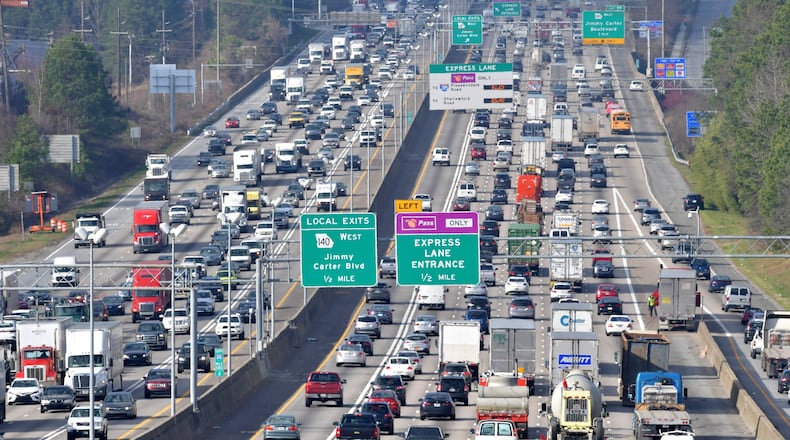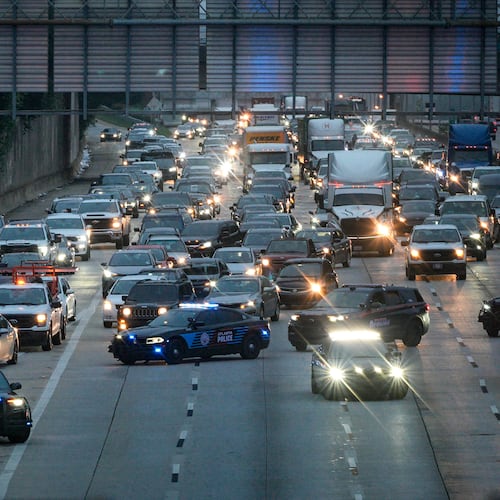The struggle to tame traffic on metro Atlanta highways is turning back to I-85 in Gwinnett County.
The county and the Georgia Department of Transportation are considering dozens of options to get traffic moving on an 18-mile stretch of the highway from I-985 to the Perimeter. The ideas include building more toll lanes, rebuilding interchanges and improving nearby roads. They also include transit, bike and pedestrian trails and other improvements to aid travel along the corridor.
Final recommendations are a couple of years away, but state and local officials want public feedback on the options now. One local official says the ultimate solutions should focus as much on moving people as vehicles.
“It’s not just about the automobile,” said Joe Allen, executive director of the Gwinnett Place Community Improvement District. “To me, it’s about quality of life. People want to be in a place they can walk. People want more and more sidewalks.”
In recent years GDOT has spent hundreds of millions of dollars improving metro Atlanta highways. It’s opened new toll lanes on I-75 south of Atlanta and on I-75 and I-575 northwest of the city. It’s planning similar lanes on the Perimeter and Ga. 400.
It’s rebuilding the I-285 interchange at Ga. 400 and planning to do the same at I-20 east and west of the city.
GDOT also has made some significant improvements to I-85 over the past decade. In 2011 it opened toll lanes on I-85 between Old Peachtree Road and Chamblee Tucker Road. Three years ago, it extended those lanes to Hamilton Mill Road.
The agency also built diverging-diamond interchanges at Jimmy Carter Boulevard in 2012 and at Pleasant Hill Road the following year. But traffic volumes grew more than 7% between 2011 and 2019, and the corridor remains congested.
Some 307,000 vehicles use the stretch of highway each day. GDOT says up to 16% of those vehicles are carrying freight, and two-thirds of those trucks stop in the area.
Not surprisingly, traffic can be a mess, with southbound congestion stretching for 11 miles on weekday mornings.
To address the problem, GDOT and Gwinnett launched a study of the I-85 corridor in 2019. Now they’re considering dozens of ways to keep traffic and people moving. Among the projects that will advance to a second phase of study:
- Adding one or more toll lanes in each direction on I-85, two trucks-only lanes in each direction or a combination of toll and trucks-only lanes.
- Adding “auxiliary” lanes at various interchanges to allow motorists to merge into freeway traffic and prevent bottlenecks caused by drivers trying to enter or exit I-85. The interchanges include Jimmy Carter, Indian Trail-Lilburn Road, Beaver Ruin Road and Steve Reynolds Boulevard.
- Rebuilding numerous interchanges, including the Jimmy Carter and Pleasant Hill diverging diamonds. Allen said those interchanges have worked well, but they will become overloaded in the future as traffic increases.
The study also will examine consolidating ramps at Spaghetti Junction, where I-85 meets the Perimeter.
- Widening or otherwise improving nearby roads, including Jimmy Carter, Steve Reynolds, Sugarloaf Parkway and Lawrenceville-Suwanee Road.
- Adding transit and bike and pedestrian paths to move people along I-85 and elsewhere in the corridor. Gwinnett County already plans bus rapid transit service in the area.
One big obstacle: County voters have twice rejected sales tax referendums to pay for more transit service in recent years. Nonetheless, state and county officials say transit is a key component of the I-85 study.
“Will this add a bus route? No,” Gwinnett Assistant Transportation Director Tom Sever said. “But will it consider how we move our commuter buses along the corridor? That needs to be incorporated.”
In a written statement, GDOT said the goals of the study include improving safety, reducing congestion, facilitating freight movement and supporting local communities.
More than 530,000 people live in the area that GDOT and Gwinnett County are studying. It also includes more than 30,000 businesses and 340,000 jobs.
Allen, the community improvement district director, said a focus on community will be crucial as Gwinnett adds hundreds of thousands of residents in the coming decades. He thinks transit, bike and pedestrian trails, sidewalks and other alternatives to driving will be a big part of the solution.
“Especially in Gwinnett, we’re talking more and more about trails and that kind of connectivity,” he said. “We’ve got to have these options available to us.”
I-85 study
Gwinnett County and the Georgia Department of Transportation are seeking public input through Sept. 3 on dozens of possible ways to improve traffic in the I-85 corridor. They will also host a live virtual public meeting at 11:30 a.m. Aug. 26.
For more information, to comment on the proposals or to participate in the live meeting, visit www.85study.com.
About the Author
The Latest
Featured



